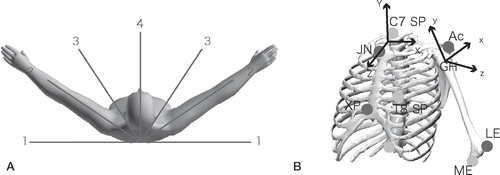Figures & data
Figure 1 A. Both arms were moved symmetrically from the dependent position with neutral rotation to the maximum elevated position in 4 different planes, referring to tapes attached to the floor at regular intervals of 30°. B. Local thoracic and humeral coordinate systems were defined using bony landmarks. The local thoracic system (X, Y, Z) is defined as: Y = ((JN + C7) / 2 – (XP + T8) / 2) / |((JN + C7) / 2 – (XP + T8) / 2)|; X: perpendicular to plane JN, C7, (XP + T8) / 2; and Z: perpendicular to Y and X. The local humeral coordinate system (x, y, z) is defined as: y = (GH – (ME + LE) / 2) / |(GH – (ME + LE) / 2)|; z: perpendicular to y and LE – ME; and x: perpendicular to y and z. Abbreviations are as defined in the text.

Table 1. Passive range of motion (degrees) for the left and right shoulders in 15 men. Values are mean (SD).
Table 2. Mean (SD) angles of horizontal abduction at 60°, 90°, and 120° of abduction along 4 paths.
Figure 2. A. Rotational angles of the right arm during abduction in the first plane (coronal plane) representing type A. B. Rotational angles of the right arm during abduction in the fourth plane (sagittal plane) representing type B.

Table 3. Mean (SD) angles of axial rotation at 60°, 90°, and 120° (both types).
Table 4. Maximal angles (SD) of external rotation during the elevation along 4 paths.